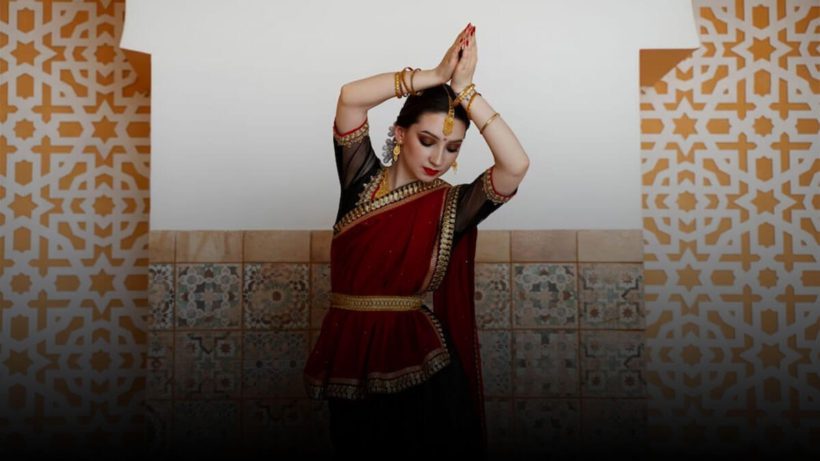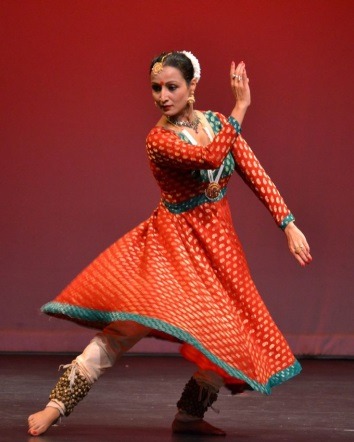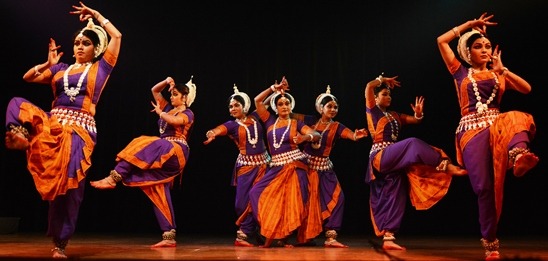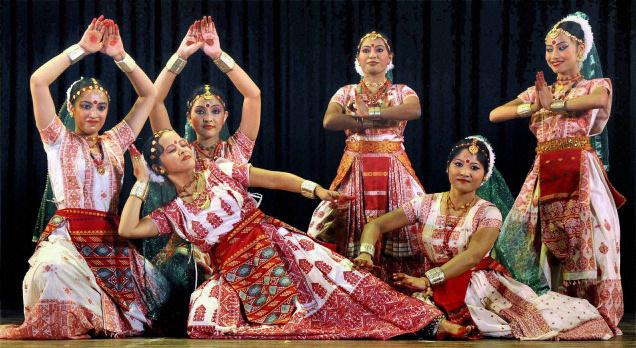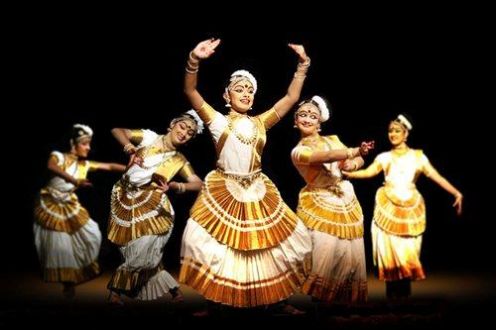Classical Dances of India
The principles of Indian Classical dance is derived from ‘Natya Shastra’ by Bharat Muni. He traces its origin from lord Bramha & dictated that Lord Bramha created a fifth veda known as ‘Natyaveda’, representing the essence of four existing Vedas. Pathya (words) were taken from Rigveda, Abhinaya (gestures) from Yajurveda, Geet (music) from Samaveda, Rasa (emotions) from Atharvaveda.
- Can only be performed by trained dancers + have very particular meanings for each step, known as “Mudras”.
- Three main components form the basis of these dances viz.
| Natya | the dramatic element of the dance (i.e., the imitation of character) |
| Nritta | pure dance, in which the rhythms and phrases of the music are reflected via body gestures |
| Nritya | the portrayal of mood through facial expression, hand gesture, and position of the legs & feet |
- There are two basic aspect of Indian classical dance viz.
| Tandava | emphasize on male characteristics of power strength and firmness |
| Lasya | denotes grace, bhava, rasa and abhinaya, which represents the feminine aspect of dance |
Bharatnatyam (Tamilnadu)
- One dancer takes on many roles in a single performance [arr] Also known as Poetry in motion
- Style was kept alive by the devadasis (young girls ‘gifted’ by their parents to the temples & who were married to the gods)
- Devadasis performed music and dance as offerings to the deities, in the temple courtyards
- Bharatnatyam leans heavily on the abhinaya or mime aspect of dance [arr] Dancer expresses the sahitya through movement
- The performance ends with amangalam invoking the blessings of the Gods.
- The accompanying orchestra consists of a vocalist, a mridangam player, a violinist or veena player, a flautist and a cymbal player.
- The person who conducts the dance recitation is known as the Nattuvanar
Kathak (Uttar Pradesh)
- Kathakars or story-tellers, are the people who narrate stories, largely based on episodes from the epics, myths and legends
- Probably started as an oral tradition with Mime & gestures added lately to make the recitation more effective
- Vaishnavism (15th century) became the prominent range of lyrics and musical forms – Krishna and his leela
- Dance in Raslila was mainly an extension of the basic mime and gestures of theKathakars
- In both Hindu & Muslim courts, Kathak became highly popular source of entertainment
- Weight of the body is equally distributed along the horizontal & vertical axis
- Full foot contact is of prime importance; with no use of sharp bends of the upper or lower part of the body
- Torso movements emerge from the change of the shoulder line rather than through the manipulations of the backbone
- Both the drummer and the dancer weave endless combinations on a repetitive melodic line
- Being the only classical dance of India having links with Muslim culture, it represents a unique synthesis of Hindu and Muslim genius in art.
- Kathak is the only form of classical dance wedded to Hindustani or the North Indian music
Kuchipudi (Andhra Pradesh)
- This dance originated in Kuchipudi village, Krishna district of modern Andhra Pradesh.
- It was conceived in 17th century by Vaishnava poet Siddhendra Yogi.
- It begins with an invocation to Lord Ganesha followed by Nritta (non-narrative pure dancing), Nritya (narrative dancing) and Natya.
- The dance is performed on Carnatic music where singer is accompanied by musical instruments like mridangam, violin, flute and tambura.
- Marked by fast rhythmic footwork & sculpturesque body movements.
Kathakali (Kerala)
- Kathakali is a blend of dance, music and acting and dramatizes stories, which are mostly adapted from the Indian epics
- Conducted at night & ends in early morning [arr] Originated from Ramanattam (Ram story via 8 plays)
- A mixture of rice paste and lime is applied to make the chutti on the face, which highlights the facial make-up
- The face of the artist is painted over to appear as though a mask is worn
- The lips, the eyelashes and the eyebrows are designed to look prominent
- The technical details cover every part of the body from facial muscles to fingers, eyes, hands and wrists.
- The weight of the body is on the outer edges of the feet which are slightly bent and curved.
- The movement of the eyebrows, the eye-balls and the lower eye-lids as described in the Natya Shastra are not used to such an extent in any other dance style
- The characters in a Kathakali performance are broadly divided into Satvika, Rajasika & Tamasika types
- Satvika characters are noble, heroic, generous and more refined
Odissi (Odissa)
- Archaeological evidence of this dance form dates back to the 2nd century BC [arr] Found in the caves of Udayagiri & Khandagiri near Bhubaneshwar
- Probably it the the oldest classical dance of India & denotes the worship of Lord Jagannath
- The Sun Temple at Konarak, built in the 13th century, with its Natya mandap or Hall of dance, marks the culmination of the temple building activity in Orissa
- These dance movements, frozen in stone, continue to inspire Odissi dancers even today
- Themaharis, who were originally temple dancers came to be employed in royal courts which resulted in the degeneration of the art form
- Facial expressions, hand gestures and body movements are used to suggest certain feelings or emotions
- With the lower half of the body remaining static, the torso moves from one side to the other
- Great training is required for this control so as to avoid any shoulder or hip movement
- There are certain foot positions with flat, toe or heel contact; with almost all leg movements being spiral/circular
- Prominent Feature [arr] independent movement of head, chest and pelvis
- The techniques of movement are built around the two basic postures of the Chowk (above) and the Tribhanga (left).
- The chowk represents a very masculine stance with the weight of the body equally balanced.
- The tribhanga represents a very feminine stance where the body is deflected at the neck, torso and the knees
- Odissi dancer still reaffirms the faith of the maharis where they sought liberation or moksha through the medium of dance
- The accompanying orchestra includes Pakhawaj , flute, Sitar / Violin and Manjira
Sattriya (Assam)
- Introduced by the great Vaishnava saint, Mahapurusha Sankaradeva in Assam around 15th century
- Nurtured & preserved till today with great commitment by the Sattras (male dancers) in Vaishnava monasteries
Manipuri (Manipur)
- Manipur dance has a large repertoire; however, the most popular forms are the Ras, Sankirtana & Thang-Ta
- There are five principal Ras dances of which four are linked with specific seasons, while the fifth can be presented at any time of the year
- In Manipuri Ras, the main characters are Radha, Krishna and the Gopis
- Dancers feet never strike the ground hard
- Radha wears a short fine white muslin skirt with a dark velvet blouse; & a traditional white veil to cover the face.
- Krishna wears a yellow dhoti, a dark velvet jacket and a crown of peacock feathers
- The Kirtan form of congregational singing accompanies the dance which is known as Sankirtana in Manipur.
- The martial dancers of Manipur – the Thang-ta – have their origins in the days when man’s survival depended on his ability to defend himself from wild animals.
- The main musical instrument is the Pung or the Manipuri classical drum
Mohiniyattam (Kerala)
- A feminine classical dance form; literally meaning the Dance of the Enchantress
- It is deeply rooted in femininity, Grace (Lasya) and Beauty (Sringara) forming the quintessence of this dance form
- Distinguishing feature [arr] Characteristic body movements, marked by the graceful sway of the torso
- What is unique is the easy going rise and fall of the body, with emphasis mainly on the torso
- The movements are never abrupt, but dignified, easy, natural, restrained and yet subtle
- The swaying coconut trees in the gentle breeze is reminiscent of the soft and languorous movements of Mohiniyattam
- The traditional costume worn in Mohiniyattam is white with a gold border, along with the gold ornaments
- The unique coiffure with hair gathered on the left side of the head reflect its aesthetic appeal
- Accompanying music [arr] Sopana style, which in its lyricism, is evocative of the spiritual element
